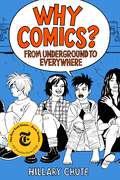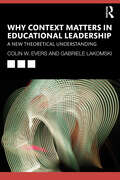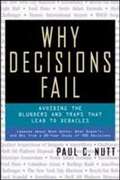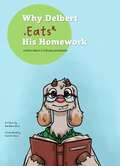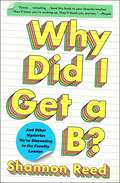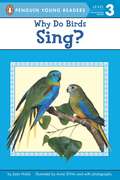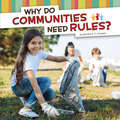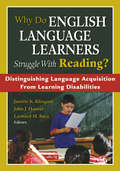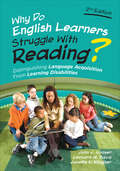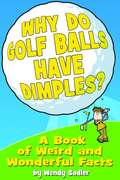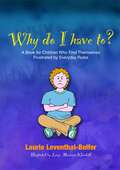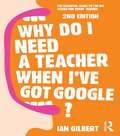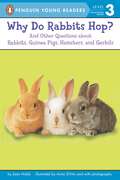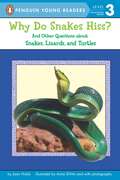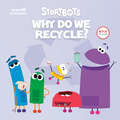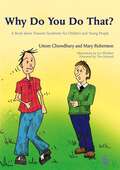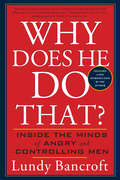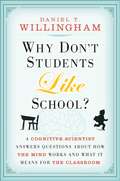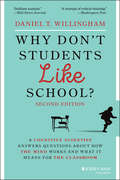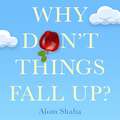- Table View
- List View
Why College Matters to God, Revised Edition: An Introduction to the Christian College
by Rick OstranderA brief introduction to the unique purpose and nature of a Christian college education for students, their parents, teachers, and others.The new edition expands the discussion of Christian worldview beyond intellectual analysis to include actions and attitudes. Sections on the Christian mind, redemption, and cultural engagement have been revised to incorporate the recent insights of Christian thinkers such as Andy Crouch, James Davison Hunter, Gabe Lyons, Mark Noll, and James K. A. Smith.
Why Comics?: From Underground to Everywhere
by Hillary ChuteFilled with beautiful full-color art, dynamic storytelling, and insightful analysis, Hillary Chute’s Why Comics? reveals what makes one of the most critically acclaimed and popular art forms unique and so appealing, and how it got that way. <p><p> Over the past century, fans have elevated comics from the back pages of newspapers into one of our most celebrated forms of culture, from Fun Home, the Tony Award–winning musical based on Alison Bechdel’s groundbreaking graphic memoir, to the dozens of superhero films that are annual blockbusters worldwide. What is the essence of comics’ appeal? What does this art form do that others can’t? <p> Whether you’ve read every comic you can get your hands on or you’re just starting your journey, Why Comics? has something for you. Author Hillary Chute chronicles comics culture, explaining underground comics (also known as “comix”) and graphic novels, analyzing their evolution, and offering fascinating portraits of the creative men and women behind them. Chute reveals why these works—a blend of concise words and striking visuals—are an extraordinarily powerful form of expression that stimulates us intellectually and emotionally. <p> Focusing on ten major themes—disaster, superheroes, sex, the suburbs, cities, punk, illness and disability, girls, war, and queerness—Chute explains how comics gets its messages across more effectively than any other form. “Why Disaster?” explores how comics are uniquely suited to convey the scale and disorientation of calamity, from Art Spiegelman’s representation of the Holocaust and 9/11 to Keiji Nakazawa’s focus on Hiroshima. “Why the Suburbs?” examines how the work of Chris Ware and Charles Burns illustrates the quiet joys and struggles of suburban existence; and “Why Punk?” delves into how comics inspire and reflect the punk movement’s DIY aesthetics—giving birth to a democratic medium increasingly embraced by some of today’s most significant artists. <p> Featuring full-color reproductions of more than one hundred essential pages and panels, including some famous but never-before-reprinted images from comics legends, Why Comics? is an indispensable guide that offers a deep understanding of this influential art form and its masters.
Why Context Matters in Educational Leadership: A New Theoretical Understanding
by Gabriele Lakomski Colin EversWhy Context Matters in Educational Leadership: A New Theoretical Understanding is unique in the field of educational leadership studies. This book offers a systematic account of educational leadership from the perspective that context matters. It argues that studies of leadership in education can only progress if the importance of context is understood and presents context as a set of constraints under which leadership is exercised. A theoretical book that offers at last three major challenges to dominant positions in the field in a systematic way, it provides a new, coherent, and more realistic way to think about leadership in context.The chapters offer concrete steps for complex problem-solving in schools and will help schools tailor solutions to local constraints and circumstances. Written by leading scholars Colin W. Evers and Gabriele Lakomski, this book will be essential reading for students and researchers working in the fields of education, educational administration and leadership.
Why Decisions Fail: Avoiding the Blunders and Traps That Lead to Debacles
by Paul C. NuttWhy Decisions Fail critiques 15 infamously bad decisions that became public debacles. Including the Firestone tire recall and Quaker's failed acquisition of Snapple, the author examines how these mistakes could have been avoided and explains how any organization's decision-making process can be improved to prevent such failures. Author Paul Nutt began by looking at 400 decisions made by top managers involving such topics as products and services, pricing and markets, personnel policy, technology acquisition, and strategic reorganization. Analyzing how each decision was made, he determined that two out of three decisions were based on failure-prone or questionable tactics. He identifies these key errors and suggests alternatives that have proven successful.
Why Delbert Eats His Homework: A Book About A Struggling Reader
by Barbara BossDelbert is a struggling reader who loves using his big blinky eyes and clowning around at recess to get through his reading disability at school. He musters the courage to talk about his troubles with his mama and teacher who promise to help him find answers. Delbert’s doc finds things that will help, but Delbert schemes to use the appointments to get more ice cream. Can they really help Delbert? Will Delbert ever love school again? See what really makes a difference. Weather a child has dyslexia or other reading difficulties, getting behind in school can destroy self-confidence and create feelings of inferiority. Delbert feels withdrawn and ashamed before getting help. This is a story of a triumph over learning disabilities through hard work.
Why Did I Get a B?: And Other Mysteries We're Discussing in the Faculty Lounge
by Shannon Reed&“Funny...revealing....So send this book to your favorite teacher. They&’ll know you&’re sucking up. They&’ll thank you anyway.&” —People, Book of the Week This hilarious, inspirational, and wise collection of personal essays and humor from a longtime educator explores all the joys, challenges, and absurdities of being a teacher, following in the footsteps of such classics as Teach Like Your Hair&’s on Fire, The Courage to Teach, and Up the Down Staircase. Shannon Reed did not want to be a teacher, but now, after twenty years of working with children from preschool to college, there&’s nothing she&’d rather be. In essays full of humor, heart, and wit, she illuminates the highs and lows of a job located at the intersection of youth and wisdom. Bringing you into the trenches of this most important and stressful career, she rolls her eyes at ineffectual administrators, weeps with her students when they experience personal tragedies, complains with her colleagues about their ridiculously short lunchbreaks, and presents the parent-teacher conference from the other side of the tiny table. From dealing with bullies and working with special needs students to explaining the unwritten rules of the teacher&’s lounge, Why Did I Get a B? is full of as much humor and heart as the job itself.
Why Do Birds Sing? (Penguin Young Readers, Level 3)
by Joan HolubDo you love birds? If you do, you're not alone! Birds are fun to watch and they make great pets. There is so much to know about birds. Why do they have feathers? Can parrots really talk? Why do birds build nests? Do birds like toys? Beginning readers will find the answers to these questions—and many more—in this lively, fact-filled book. Filled with colorful illustrations and photographs of wild and domestic birds, this is a perfect selection for any young bird-watcher or bird lover.
Why Do Communities Need Rules? (Community Questions)
by Martha E. RustadNo matter their size, all communities need rules to keep their members safe, healthy, and happy. A question-answer format and kid-friendly photos show how both written rules (e.g., traffic laws) and unwritten rules (e.g., character values such as honesty) help communities grow and thrive. A simple activity promotes active community participation.
Why Do Dogs Bark? (Penguin Young Readers, Level 3)
by Joan HolubThere are many different kinds of dogs and so much to find out about them. Why do dogs bark, howl, or bury bones? Why do they like to lick and sniff people? What jobs can dogs do? You'll find the answers to these questions and many more in this fact-filled reader about man's best friend.
Why Do English Learners Struggle With Reading?: Distinguishing Language Acquisition From Learning Disabilities
by John J. Hoover Leonard M. Baca Janette Kettmann KlingnerMake the right instructional and eligibility decisions to help your English Learners! Do your students' reading difficulties reflect language acquisition issues or a learning disability? Now in an updated second edition, this essential guide helps educators make informed choices about strategies and services to support English Learners, and includes: Nine common misconceptions that can lead to wrongful placement of students in Special Education A new chapter on evidence-based practices for success in teaching reading to students learning English Appropriate techniques to use when assessing students for special education Expanded coverage of Response to Intervention to include a multi-tiered system of supports (MTSS)
Why Do English Learners Struggle With Reading?: Distinguishing Language Acquisition From Learning Disabilities
by John J. Hoover Leonard M. Baca Janette Kettmann KlingnerMake the right instructional and eligibility decisions to help your English Learners! Do your students' reading difficulties reflect language acquisition issues or a learning disability? Now in an updated second edition, this essential guide helps educators make informed choices about strategies and services to support English Learners, and includes: Nine common misconceptions that can lead to wrongful placement of students in Special Education A new chapter on evidence-based practices for success in teaching reading to students learning English Appropriate techniques to use when assessing students for special education Expanded coverage of Response to Intervention to include a multi-tiered system of supports (MTSS)
Why Do English Learners Struggle With Reading?: Distinguishing Language Acquisition From Learning Disabilities
by John J. Hoover Leonard M. Baca Janette Kettmann KlingnerMake the right instructional and eligibility decisions to help your English Learners! Do your students' reading difficulties reflect language acquisition issues or a learning disability? Now in an updated second edition, this essential guide helps educators make informed choices about strategies and services to support English Learners, and includes: Nine common misconceptions that can lead to wrongful placement of students in Special Education A new chapter on evidence-based practices for success in teaching reading to students learning English Appropriate techniques to use when assessing students for special education Expanded coverage of Response to Intervention to include a multi-tiered system of supports (MTSS)
Why Do Golf Balls Have Dimples?: A Book of Weird and Wonderful Science Facts
by Wendy SadlerHave you ever wondered why golf balls have dimples or why your hair goes frizzy in the rain? Scientist Wendy Sadler has the answers in her book of Weird and Wonderful facts. Broken down into user-friendly chapters like sport, going out, the great outdoors, food and drink and the downright weird, Wendy gives the scientific answers to life's intriguing questions, like Why toast always lands butter side down Why you can't get (too) lost with a satnav.
Why Do I Have To?: A Book for Children Who Find Themselves Frustrated by Everyday Rules
by Laurie Leventhal-Belfer Luisa Montaini-Klovdahl'If you want a child with Asperger's syndrome to comply with a social or family rule, it is very important to explain the logical reason to comply. Laurie's book provides the logic for compliance that will be invaluable for parents and teachers. I know this book will become regular bed time reading and be used many times at home and at school.' - Professor Tony Attwood 'Dr. Laurie clearly understands how children with limited flexibility and difficulty coping think and respond. She has used her clinical experience to teach us how to help these children succeed. Dr. Laurie has provided a format, similar to Social Stories (TM), for reducing stress in daily life and for minimizing conflict stemming from unwritten or everyday rules. While there is no one solution for every child, the stories can be easily adapted for each child. She encourages children to be participants in determining solutions to their problems by providing simple, not simplistic, methods that work.' -Teri Wiss, M.A., O.T.R./L., Director of Development is CHILD'S PLAY! Why do I have to go to school before the show that I am watching is over? Why do I have to wear shoes and a jacket when I go outside? Rules like these can be really frustrating - but they don't have to be! Why do I have to? looks at a set of everyday situations that provide challenges for children at home, with their friends, and at school. Laurie Leventhal-Belfer empathizes with children's wish to do things their way, explains clearly why their way does not work, and provides a list of practical suggestions for how to cope with these challenges and avoid feelings of frustration. This is the ideal book for children who have difficulty coping with the expectations of daily living, as well as for their parents and the professionals who work with them.
Why Do I Have to Read This?: Literacy Strategies to Engage Our Most Reluctant Students
by Cris TovaniWhy do I have to read this?- What teacher doesn't dread this question? It usually comes from our most disengaged students a student who cries of boredom, or one who is angry or apathetic. When we don't know what else to try, it's easy to become frustrated and give up on these challenging learners. Author Cris Tovani has spent her career figuring out how to entice challenging students back into the process of learning. Why Do I Have to Read This?: Literacy Strategies to Engage our Most Reluctant Students Tovani shares her best secrets, lessons learned from big fails, and her most effective literacy and planning strategies that hook these hard to get learners. You will meet many of Tovani's students inside this book. As she describes some of her favorites, you may even recognize a few of your own. You will laugh at her stories and take comfort in her easily adaptable strategies that help students remove their masks of disengagement. She shows teachers how to plan by anticipating students' needs. HerC urriculumY ouA nticipate structures of Topic, Task, Targets, Text, Tend to me, and Time willhelp you anticipate your curriculum. InsideWhy Do I Have to Read This? readers will find: Literacy strategies for all content areas that support and engage a wide range of learners so they can read and write a variety of complex textReference charts packed with small bites of instructional shifts that coaches and teachers can use to quickly adjust instruction to re-engage studentsPlanning strategies that show teachers how to connect day-to-day instruction so that no day lives in isolationVersatile think sheets that are reproducible and adaptable to different grade levels, content areas, and disciplinesAbove all, Tovani gives teachers energy to get back into the classroom and face students who wear masks of disengagement. She reminds us of the importance of connecting students to compelling topics, rich text, useful targets, and worthy tasks. Teachers must tendto students' basic needs and helps us consider how to best structure instructional time.After reading this book, teachers will have new ways to connect with students in a deep, authentic way. Written in a humorous, compassionate, and wise voice,Why Do I Have to Read This? will provide answers to the pressing questions we have when we try to teach and reach all of our students.
Why Do I Need a Teacher When I've got Google?: The essential guide to the big issues for every teacher
by Ian GilbertWhy do I need a teacher when I’ve got Google? is just one of the challenging, controversial and thought-provoking questions Ian Gilbert poses in this urgent and invigorating book. Questioning the unquestionable, this fully updated new edition will make you re-consider everything you thought you knew about teaching and learning, such as: • Are you simply preparing the next generation of unemployed accountants? • What do you do for the ‘sweetcorn kids’ who come out of the education system in pretty much the same state as when they went in? • What’s the real point of school? • Exams – So whose bright idea was that? • Why ‘EQ’ is fast becoming the new ‘IQ’. • What will your school policy be on brain-enhancing technologies? • Which is the odd one out between a hamster and a caravan? With his customary combination of hard-hitting truths, practical classroom ideas and irreverent sense of humour, Ian Gilbert takes the reader on a breathless rollercoaster ride through burning issues of the twenty-first century, considering everything from the threats facing the world and the challenge of the BRIC economies to the link between eugenics and the 11+. As wide-ranging and exhaustively-researched as it is entertaining and accessible, this book is designed to challenge teachers and inform them – as well as encourage them – as they strive to design a twenty-first century learning experience that really does bring the best out of all young people. After all, the future of the world may just depend on it
Why Do Only White People Get Abducted by Aliens?: Teaching Lessons from the Bronx
by Ilana GaronAccording to Ilana Garon, popular books and movies are inundated with the myth of the "hero teacher"--the one who charges headfirst into dysfunctional inner city schools like a firefighter into an inferno, bringing the student victims to safety through a combination of charisma and innate righteousness. The students are then "saved" by the teacher's idealism, empathy, and willingness to put faith in kids who have been given up on by society as a whole."Why Do Only White People Get Abducted by Aliens?" is not that type of book.In this book, Garon reveals the sometimes humorous, oftentimes frustrating, and occasionally horrifying truths that accompany the experience of teaching at a public high school in the Bronx today. The overcrowded classrooms, lack of textbooks, and abundance of mice, cockroaches, and drugs weren't the only challenges Garon faced during her first four years as a teacher. Every day, she'd interact with students such as Kayron, Carlos, Felicia, Jonah, Elizabeth, and Tonya--students dealing with real-life addictions, miscarriages, stints in "juvie," abusive relationships, turf wars, and gang violence. These students also brought with them big dreams and uncommon insight--and challenged everything Garon thought she knew about education.In response, Garon--a naive, suburban girl with a curly ponytail, freckles, and Harry Potter glasses--opened her eyes, rolled up her sleeves, and learned to distinguish between mitigated failure and qualified success. In this book, Garon explains how she learned that being a new teacher was about trial by fire, making mistakes, learning from the very students she was teaching, and occasionally admitting that she may not have answers to their thought-provoking (and amusing) questions.
Why Do Rabbits Hop?: And Other Questions About Rabbits, Guinea Pigs, Hamsters, And Gerbils (Penguin Young Readers, Level 3)
by Joan HolubWhy Do Rabbits Hop?And Other Questions about Rabbits, Guinea Pigs, Hamsters, and GerbilsDid you know that rabbits can jump 10 feet in one hop, guinea pigs bump noses to say hello, and baby gerbils are called pups?
Why Do Snakes Hiss?: And Other Questions About Snakes, Lizards, and Turtles (Penguin Young Readers, Level 3)
by Joan HolubMany people like snakes, lizards, and turtles, and there's so much to find out about all of these scaly-skinned animals. Are all snakes poisonous? Why do snakes shed their skin? What unusual things can lizards do? Do lizards ever lose their tails? Why do turtles have shells? Kids will find the answers—and much more—in this fun, fact-filled introduction to reptiles. Filled with colorful photographs and illustrations, this is just right for any reptile lover.
Why Do We Recycle? (Pictureback(R))
by Scott EmmonsThe curious crew from Netflix's Ask the StoryBots star in an all-new storybook about recycling that includes over 30 stickers! Bing, Bo, and the rest of Netflix&’s StoryBots want to know where garbage goes. Join them on an adventure that takes them from the landfill to the recycling plant. Children ages 3 to 7 who love Ask the StoryBots will thrill to this fun and fascinating storybook that includes over 30 stickers. The stars of Netflix&’s Ask the StoryBots are curious little robots who bring a world of learning and fun to kids ages 2 to 7 across a broad range of subjects with their animated series. All of the award-winning StoryBots content is developed by teachers and early-education experts.
Why Do You Do That?: A Book about Tourette Syndrome for Children and Young People
by Mary Robertson Uttom ChowdhuryWritten specifically for siblings of children with Tourette Syndrome (TS), Why Do You Do That? is an age-appropriate source of information for children and adolescents aged 8 to 16. Uttom Chowdhury and Mary Robertson describe tics and Tourette's in clear, child-friendly terms and provide a simple explanation of the biological causes. Other chapters focus on living with someone who has TS, associated features such as obsessive-compulsive disorder, attention deficit/hyperactivity disorder and aggression, and what siblings can do to help. The authors also offer practical tips on how to deal with issues such as problems at school and bullying. This book will prove invaluable for brothers and sisters of children with TS, as well as parents and other family members.
Why Does He Do That?: Inside the Minds of Angry and Controlling Men (Stylecity Ser.)
by Lundy BancroftIn this groundbreaking bestseller, Lundy Bancroft—a counselor who specializes in working with abusive men—uses his knowledge about how abusers think to help women recognize when they are being controlled or devalued, and to find ways to get free of an abusive relationship.He says he loves you. So...why does he do that? You&’ve asked yourself this question again and again. Now you have the chance to see inside the minds of angry and controlling men—and change your life. In Why Does He Do That? you will learn about: • The early warning signs of abuse• The nature of abusive thinking• Myths about abusers• Ten abusive personality types• The role of drugs and alcohol• What you can fix, and what you can&’t• And how to get out of an abusive relationship safely&“This is without a doubt the most informative and useful book yet written on the subject of abusive men. Women who are armed with the insights found in these pages will be on the road to recovering control of their lives.&”—Jay G. Silverman, Ph.D., Director, Violence Prevention Programs, Harvard School of Public Health
Why Don't Students Like School
by Daniel T. Willingham<P>Easy-to-apply, scientifically-based approaches for engaging students in the classroom Cognitive scientist Dan Willingham focuses his acclaimed research on the biological and cognitive basis of learning. His book will help teachers improve their practice by explaining how they and their students think and learn. It reveals-the importance of story, emotion, memory, context, and routine in building knowledge and creating lasting learning experiences. <P>"Mr. Willingham's answers apply just as well outside the classroom. Corporate trainers, marketers and, not least, parents -anyone who cares about how we learn-should find his book valuable reading. " -Wall Street Journal
Why Don't Students Like School?: A Cognitive Scientist Answers Questions About How the Mind Works and What It Means for the Classroom
by Daniel T. WillinghamResearch-based insights and practical advice about effective learning strategies In this new edition of the highly regarded Why Don't Students Like School? cognitive psychologist Daniel Willingham turns his research on the biological and cognitive basis of learning into workable teaching techniques. This book will help you improve your teaching practice by explaining how you and your students think and learn. It reveals the importance of story, emotion, memory, context, and routine in building knowledge and creating lasting learning experiences. With a treasure trove of updated material, this edition draws its themes from the most frequently asked questions in Willingham’s “Ask the Cognitive Scientist” column in the American Educator. How can you teach students the skills they need when standardized testing just requires facts? Why do students remember everything on TV, but forget everything you say? How can you adjust your teaching for different learning styles? Read this book for the answers to these questions and for practical advice on helping your learners learn better. Discover easy-to-understand, evidence-based principles with clear applications for the classroom Update yourself on the latest cognitive science research and new, teacher-tested pedagogical tools Learn about Willingham’s surprising findings, such as that you cannot develop “thinking skills” without facts Understand the brain’s workings to help you hone your teaching skills Why Students Don’t Like School is a valuable resource for both veteran and novice teachers, teachers-in-training, and for the principals, administrators, and staff development professionals who work with them.
Why Don't Things Fall Up?: and Six Other Science Lessons You Missed at School
by Alom ShahaEverything you once learnt in science class, but have definitely forgotten along the wayHas a child - or anyone else - ever asked you why the sky is blue? Could you explain why ice cream melts? Have you forgotten why scientists think the universe started with a Big Bang, and do you understand the difference between respiration and breathing?Why Don't Things Fall Up? will gently remind you of everything you may have learnt once upon a time, but have somehow forgotten along the way. If you've ever changed the subject when a child has asked for homework help, or if you have the curiosity of a seven year old yourself, or if you know everything but have forgotten the basics or don't want to know anything except the basics - then this is the book for you. Using questions asked by children as a starting point, Alom Shaha (who has spent over two decades trying to help people of all ages understand this stuff) takes us on a tour of the "big ideas" of science from his unique perspective. His experience as a dad, a teacher and science communicator means he knows exactly what people don't know -and especially the misconceptions and other intellectual hurdles which prevent us from grasping key ideas. Combining his proven skill for explaining science with storytelling and flashbacks to school experiments, Why Don't Things Fall Up? reminds us that science is not just for scientists - it's a human endeavour that enriches all our lives.(P) 2023 Hodder & Stoughton Limited

